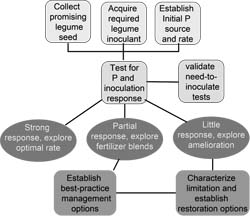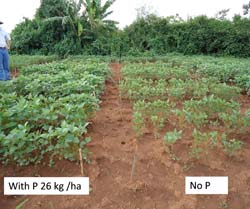N2Africa has invested substantially in identifying the best grain legume varieties and appropriate management practices for integration into African farming systems. Variety trials were conducted to acquire promising varieties of bean, cowpea, groundnut and soyabean, comparing them to current lines for yield, N2-fixing capacity and adaptation to abiotic and biotic stresses. Input trials are conducted to assign the best-fit agronomic practices to the best varieties.
In total 266 varietal tests were conducted across the project. About half of these related to soyabean and the rest the rest were divided over the three other crops. Three soyabean varieties for each of the impact zone were selected that are high yielding, early maturing, with high BNF potential and with farmer preferred characteristics. Five of these varieties were ‘old’ varieties and already well established with the farmers community: TGx1740-2F, TGx1448-2E, TGx1485-1D, Salintuya and Makwacha. SC-SAGA and TGx1987-62F were the ‘new’ varieties that are tolerant to soyabean rust. Six common bean varieties (4 climbing beans and 2 bush beans) were selected for the East and Central Highland area, all fixing on average more N2 than the 51 kg/ha set as target value. Three cowpea varieties were selected for each, the West African and the Southern Africa region, and 7 groundnut varieties (3 for the West Africa region and 4 for the South Africa region), all meeting the targets for BNF, 55 and between 45 and 60 kg/ha respectively. As was postulated by the N2Africa project, enhancing the productivity of already existing legume varieties increases the BNF significantly.
For developing best-practice management options the project followed a stepwise approach depicted in Figure 1. Different types of phosphorus fertilizers were used depending on their local availability.
Yield increase following P application was recorded across the Impact Zones in 60% of trials, with yield increase of 5-50% depending on P-source, the type of legume and the site (e.g. Plate 1).
Application of inoculants in conjunction with P greatly increased soyabean yields at many sites, with an overall increase of 47% compared to no-inoculated controls.
 |
Left: Figure 1. The stepwise approach to developing best-practice management options employed by N2Africa Right: Plate 1. Response of soyabean to modest application of phosphorus was the first approach to better managing BNF |
 |
Following deficiency symptoms observed on partially responsive sites in Kenya, experiment were done with the various additions to the P-fertilizer, which resulted in the end in a blend of the following composition: 0:23:15 plus 10% Ca, 4% S, 1% Mg and 0.1%Zn. This was tested on problem soils in Kenya, DRC and Rwanda and performed well, with yield increase from 6% to 15%). MEA Fertilizer Ltd. (Kenya) commercialized this blend under the name of Sympal. New legume fertilizer blends have also been tested in Nigeria and Zimbabwe.
Several other management considerations were addressed for inclusion into dissemination tools and extension messages including optimal plant spacing, pest and disease management, crop rotation and staking systems of climbing bean with key findings as follows:
- Optimum spacing for soyabean in Kenya is 45 cm between rows and 5 cm within row, but wider row spacings up to 75 cm are appropriate in West Africa.
- Rotation of grain legumes and maize emerged as a standard practice. Rotating maize after soyabean may result in a 1.3 t ha-1 yield increase. Crop rotation also reduces pressure of pest and disease.
- Strip cropping with several alternate rows of each crop is an alternative to mixed or row intercropping.
- Fungicide controls Asian rust on soyabean, particularly on the more susceptible varieties, increasing yields by 13%. For less rust susceptible varieties crop rotation is recommended or use of resistant varieties.
All three elements of improved production: inoculation, improved varieties and fertilizer addition, are important, but responses vary between zones and across agricultural landscapes, suggesting opportunities for more site-specific adaptation.
Freddy Baijukya, Paul Woomer and Jeroen Huising
